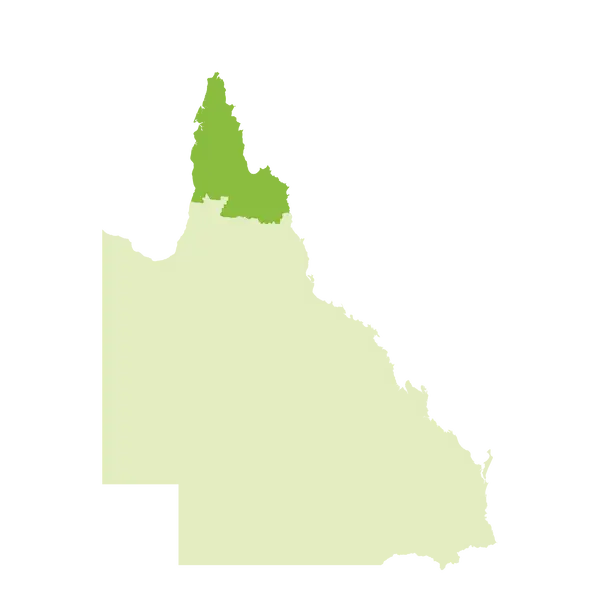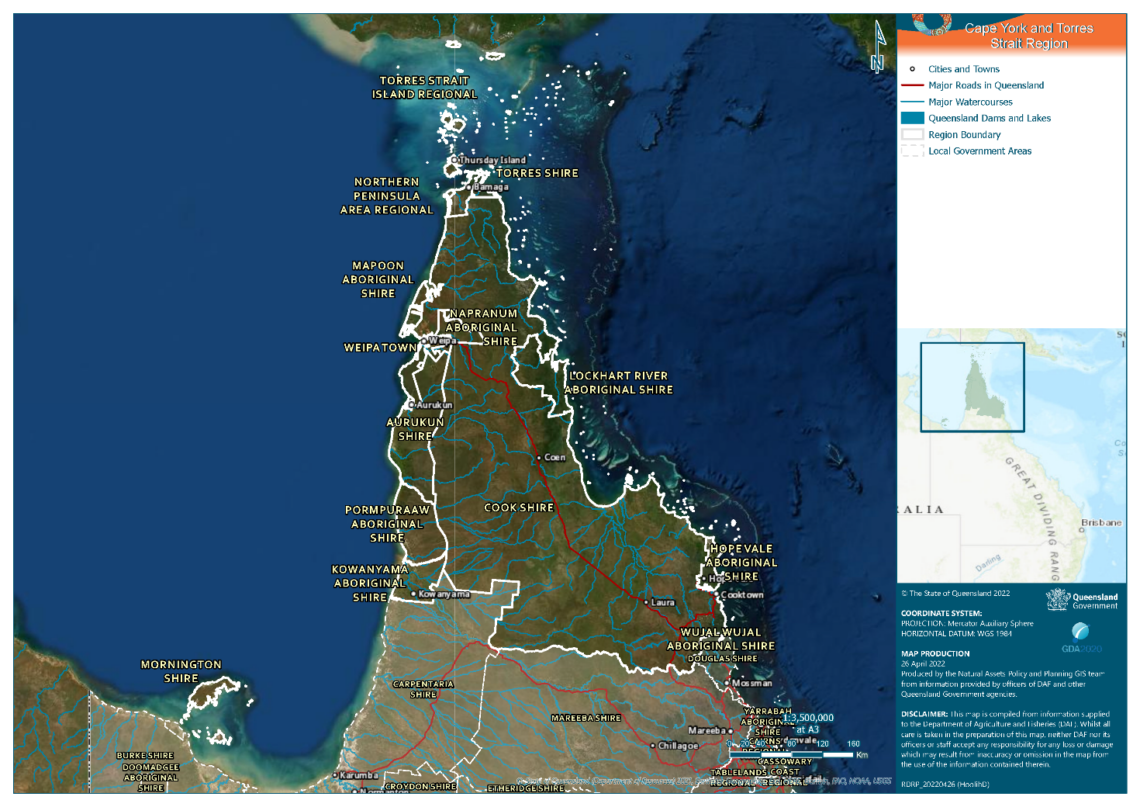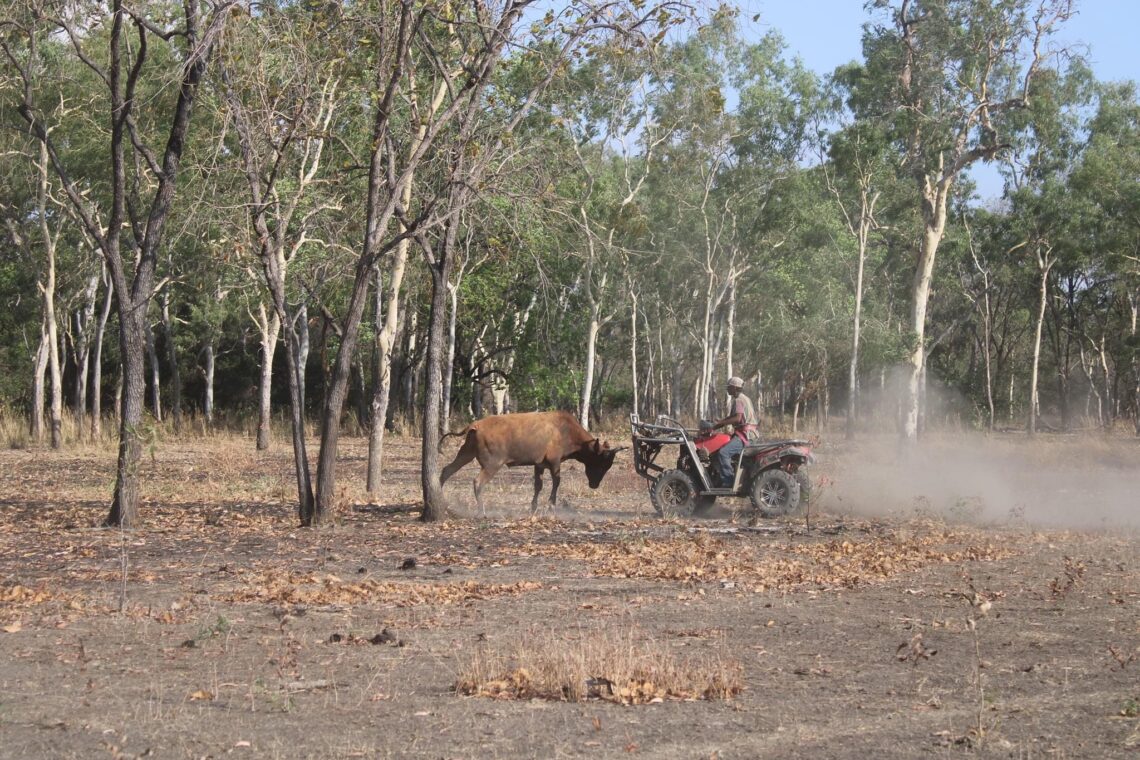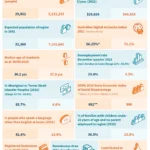

Overview of Torres Strait and Cape York

Figure 5: Cape York and Torres Strait regional map. Source: Department of Agriculture and Fisheries, Queensland Government. Cape York and Torres Strait Region
The region is an iconic part of Northern Australia and Queensland, bounded by ocean on three sides and including the northern most tip of the Australian continent.
Cape York in general is a weathered, low plain dominated by meandering rivers and large floodplains. The Torres Strait contains a group of at least 274 islands, some 18 of which are inhabited. The region also includes Mornington Island, which is in the Gulf of Carpentaria, and the largest of 22 low lying islands that form the Wellesley Islands group (Torres Cape Indigenous Council Alliance Inc, 2019). The region is an Indigenous domain and contains a wealth of leased grazing lands, Indigenous heritage, high conservation values and natural resources. It is bounded by the Coral Sea to the east, the Gulf to the west and Papua New Guinea to the north. It covers a land area of some 130,000 km2 and includes 14 Local Government areas.
Past impacts of drought in this region
The TCICA region has a unique rainfall pattern highly dominated by rainfall in the wet (November–March) and little or no rainfall in the dry (April–October).
This proves challenging to apply the traditional concept of drought, which is more easily understood in southern Australia, where the combination of deeper droughts and their impact on agriculture are perhaps more in the public eye. As with all Australian landscapes, drought, in its various forms, is a significant and predictable feature of the climate in the region. However, due to the combination of relatively high rainfall and low variability influenced by the relatively dependable southern monsoon, the incidence of traditional forms of drought are less than across most of Australia. Again, Mornington Island is perhaps the exception, with a climatic zone more similar to the Southern Gulf area. When drought occurs, however, this lack of regularity can have significant consequences.
“After wildfire have gone through, the grasses are killed and food availability for cattle is lost. There is a loss of ground cover, top soil and bare earth is exposed. When the region experiences long dry seasons, cattle feed runs out. Graziers have to purchase feed from Mareeba as irrigation and water licencing regulations prohibit them from growing their own feed. In dry periods the grasses are nutrient poor and cattle need to be supplementary fed through extended dry periods. Many graziers in the region are looking at ways to diversify their income. Many properties are destocking and moving to a carbon economy.”
Participant

Kowanyama Cattle Muster 2021. Source: Kowanyama Aboriginal Shire Council.
Likely future impacts of drought in this region
The Department of Environment and Science (2019) summarises key variables as higher temperatures, hotter and more frequent hot days, more intense downpours, less frequent but more intense tropical cyclones, rising sea-level and more frequent sea-level extremes.
Impacts on ecological and cultural places of significance will intensify, impacting Indigenous cultural practices and food security (through hunting and bush foods). Local water supply problems will worsen, affecting basic water security to communities, properties and outstations. Pastoral operations will face increasing operational risk, and the depth of dry season water insecurity will likely increase for economically impacted horticultural districts. The risk of wildfire will increase, with declining surface and groundwater availability to enable effective fire management options.

The regional drought resilience strategy
Developing, implementing and monitoring the achievement of a cohesive water security strategy for communities and outstations across the region by 2025.
Cape York and Torres Strait Islander communities and outstations are among the highest levels of water insecurity in Queensland. Drought, along with other factors (such as a lack of water metering and household over-crowding), exacerbates this situation, and in some cases, can result in the loss of basic drinking water supplies.
Without basic water security, the economic, social and cultural potential of our communities is limited.

Economic outcomes
Reduced cost risks to Councils and water service providers.

Environmental outcomes
Improved drinking water quality across the region.

Social and cultural outcomes
Improved community level health outcomes and increased community liveability.

Governance outcomes
More capacity for communities to reside in outstations to meet cultural obligations.
Mobilise available water resources to deliver drought resilient economic opportunities and food security across the region.
Historically, agriculture has been extremely limited in the region because of its remoteness, limited opportunities to store available water, generally poor soils, and the crushing impact of extreme wet/dry rainfall cycles.
With the recent Cape York Water Plan allocating some 516 GL of water to potential consumptive use, the Cape has a generational opportunity to develop a more resilient agricultural and pastoral sector for the future.

Economic outcomes
Increased economic activity and diversity within the region.

Environmenal outcomes
Processes in place to protect key regional environmental assets.

Social and cultural outcomes
Improved dietary health outcomes and social resilience of Traditional Owners/pastoralists.

Governance outcomes
Increased access to country for Traditional Owners and a stronger future for the Cape's Indigenous and non-Indigenous pastoralists.
Implement TCICA’s Digital Connectivity and Capacity Strategy to improve regional and community resilience in the face of drought and other disasters.
With drought being another broad stress on community resilience, in the region, improved participation in the digital economy would provide a major opportunity to diversify regional economies, develop improved global economic participation, improve workforce attraction and retention, and enable business competitiveness.

Economic outcomes
Increased economic opportunity and efficiency.

Environmental outcomes
Greater capacity for innovative environmental management.

Social and cultural outcomes
Increased social capital and improved health services. More effective regional governance.

Governance outcomes
Improved Traditional Owners' capacity to manage cultural values and more cultural events.
Improve the general resilience of the pastoral, horticultural and cropping sectors to manage the impacts of drought.
Cape York’s pastoral sector is vulnerable to high rainfall variability and could significantly improve industry resilience through lifting business resilience, property design, targeted small scale feed production and more opportunities to diversify incomes through natural capital markets, tourism and other ventures.

Economic outcomes
Increased economic resilience in the pastoral sector and growth in horticulture/cropping.

Environmental outcomes
Coordinated effort to maintain and enhance GBR and Gulf of Carpentaria water quality.

Social and cultural outcomes
Growth of social capital and services in key Peninsula communities.

Governance outcomes
Opportunities for Traditional Owners working on country and pastoral sector participation.
Strengthen the coordination of fire management across the region to minimise the economic, social, cultural and ecological impacts of wildfires exacerbated by drought.
With predicted climate change scenarios in the region, the broad scale risks of regularised burning regimes being disrupted by more extreme fire events weigh heavily on the minds of land managers and communities.

Economic outcomes
Reduced economic costs of fire disaster.

Environmental outcomes
Restoration and protection of culturally and environentally appropriate burning regimes.

Social and cultural outcomes
Reduced stress from bushfire risk and increased presence on country for TOs.

Governance outcomes
Protection of key cultural assets and continuation of cultural burning practices.
Improving mental health services in the region, and through better health care, bolster individual and family resilience to drought and other disasters.
A regional wide health forum hosted by TCICA in 2021 illustrated the high level of community demand for a more collaborative approach to improving preventative and acute health care arrangements across the region; one that proactively addresses the social determinants of health.

Economic outcomes
Reduced health care costs through increase in preventative health approaches.

Environmental outcomes
More people engaged in managing country in culturally appropriate ways.

Social and cultural outcomes
Improved health outcomes and liveability within the region's communities.

Governance outcomes
Improved health outcomes for the key holders of cultural knowledge in the region.
Improving the regional governance capacity at various scales within the region to plan, deliver and monitor progress towards regional disaster resilience.
All three pillars of the DRAMP Framework need to be operational. This means building long term capacity in the region and at Council and property/business scales to grow overall disaster and drought resilience. This particularly means Federal, State and Local Governments working well together and with industries and communities to support regional and local action.

Economic outcomes
Reduced economic costs of disaster.

Environmental outcomes
More efficient investment into regional environment improvements.

Social and cultural outcomes.
Improved regional social cohesion and more effective regional governance.

Governance outcomes
Greater integration of cultural considerations in planning/delivery.
Developing, implementing and monitoring the achievement of a cohesive water security strategy for communities and outstations across the region by 2025.
Cape York and Torres Strait Islander communities and outstations are among the highest levels of water insecurity in Queensland. Drought, along with other factors (such as a lack of water metering and household over-crowding), exacerbates this situation, and in some cases, can result in the loss of basic drinking water supplies.
Without basic water security, the economic, social and cultural potential of our communities is limited.

Economic outcomes
Reduced cost risks to Councils and water service providers.

Environmental outcomes
Improved drinking water quality across the region.

Social and cultural outcomes
Improved community level health outcomes and increased community liveability.

Governance outcomes
More capacity for communities to reside in outstations to meet cultural obligations.
Mobilise available water resources to deliver drought resilient economic opportunities and food security across the region.
Historically, agriculture has been extremely limited in the region because of its remoteness, limited opportunities to store available water, generally poor soils, and the crushing impact of extreme wet/dry rainfall cycles.
With the recent Cape York Water Plan allocating some 516 GL of water to potential consumptive use, the Cape has a generational opportunity to develop a more resilient agricultural and pastoral sector for the future.

Economic outcomes
Increased economic activity and diversity within the region.

Environmenal outcomes
Processes in place to protect key regional environmental assets.

Social and cultural outcomes
Improved dietary health outcomes and social resilience of Traditional Owners/pastoralists.

Governance outcomes
Increased access to country for Traditional Owners and a stronger future for the Cape's Indigenous and non-Indigenous pastoralists.
Implement TCICA’s Digital Connectivity and Capacity Strategy to improve regional and community resilience in the face of drought and other disasters.
With drought being another broad stress on community resilience, in the region, improved participation in the digital economy would provide a major opportunity to diversify regional economies, develop improved global economic participation, improve workforce attraction and retention, and enable business competitiveness.

Economic outcomes
Increased economic opportunity and efficiency.

Environmental outcomes
Greater capacity for innovative environmental management.

Social and cultural outcomes
Increased social capital and improved health services. More effective regional governance.

Governance outcomes
Improved Traditional Owners' capacity to manage cultural values and more cultural events.
Improve the general resilience of the pastoral, horticultural and cropping sectors to manage the impacts of drought.
Cape York’s pastoral sector is vulnerable to high rainfall variability and could significantly improve industry resilience through lifting business resilience, property design, targeted small scale feed production and more opportunities to diversify incomes through natural capital markets, tourism and other ventures.

Economic outcomes
Increased economic resilience in the pastoral sector and growth in horticulture/cropping.

Environmental outcomes
Coordinated effort to maintain and enhance GBR and Gulf of Carpentaria water quality.

Social and cultural outcomes
Growth of social capital and services in key Peninsula communities.

Governance outcomes
Opportunities for Traditional Owners working on country and pastoral sector participation.
Strengthen the coordination of fire management across the region to minimise the economic, social, cultural and ecological impacts of wildfires exacerbated by drought.
With predicted climate change scenarios in the region, the broad scale risks of regularised burning regimes being disrupted by more extreme fire events weigh heavily on the minds of land managers and communities.

Economic outcomes
Reduced economic costs of fire disaster.

Environmental outcomes
Restoration and protection of culturally and environentally appropriate burning regimes.

Social and cultural outcomes
Reduced stress from bushfire risk and increased presence on country for TOs.

Governance outcomes
Protection of key cultural assets and continuation of cultural burning practices.
Improving mental health services in the region, and through better health care, bolster individual and family resilience to drought and other disasters.
A regional wide health forum hosted by TCICA in 2021 illustrated the high level of community demand for a more collaborative approach to improving preventative and acute health care arrangements across the region; one that proactively addresses the social determinants of health.

Economic outcomes
Reduced health care costs through increase in preventative health approaches.

Environmental outcomes
More people engaged in managing country in culturally appropriate ways.

Social and cultural outcomes
Improved health outcomes and liveability within the region's communities.

Governance outcomes
Improved health outcomes for the key holders of cultural knowledge in the region.
Improving the regional governance capacity at various scales within the region to plan, deliver and monitor progress towards regional disaster resilience.
All three pillars of the DRAMP Framework need to be operational. This means building long term capacity in the region and at Council and property/business scales to grow overall disaster and drought resilience. This particularly means Federal, State and Local Governments working well together and with industries and communities to support regional and local action.

Economic outcomes
Reduced economic costs of disaster.

Environmental outcomes
More efficient investment into regional environment improvements.

Social and cultural outcomes.
Improved regional social cohesion and more effective regional governance.

Governance outcomes
Greater integration of cultural considerations in planning/delivery.
